Asian Small-Clawed Otter Appearance
The information below comes from Harris (1968), Duplaix-Hall(1972), Chanin (1985) and personal observation.
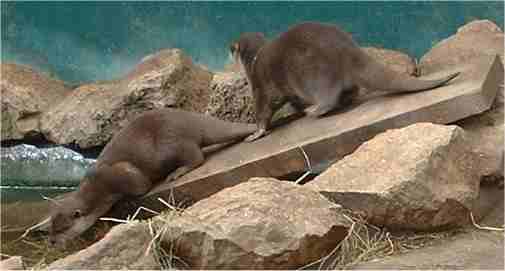
Summary
This is the smallest of the World's Otters. This species is not quite the normal otter shape - they are smaller and plumper than the 'normal' otter shape, with rounded heads and short, thick tails.
Size
| Sex | Total Length | Tail | Weight |
| Both | 65 - 95cm (25 - 37") |
24 - 30cm (9 - 12") |
2 - 6kg (5 - 13lb) |
This species displays little sexual dimorphism - males have slightly broader muzzles and thicker necks, but this is very variable.
Head and Teeth
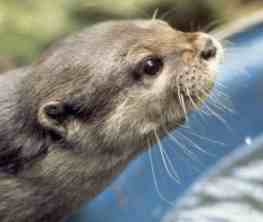 The head is less flattened than in most otters, being facially short, broad, and with
eyes set a long way forward. The skull is at most 9cm long and 6cm wide, giving a
rounded profile. The eyes are set a long way forward, with very short, round muzzle
The ears are also small, about 1cm long, and close underwater, as does the nose.
There are whiskers round the snout and nose, trailing backwards, and tufts on elbows.
They are less sturdy than in some otter species, but are very sensitive to water
disturbance. In elderly specimens, these whiskers appear to become much shorter,
and may be reduced to a small 'moustache' (personal observation).
The rhinarium is naked, with a W-shaped upper border; the nostrils are not particularly
widely set.
The head is less flattened than in most otters, being facially short, broad, and with
eyes set a long way forward. The skull is at most 9cm long and 6cm wide, giving a
rounded profile. The eyes are set a long way forward, with very short, round muzzle
The ears are also small, about 1cm long, and close underwater, as does the nose.
There are whiskers round the snout and nose, trailing backwards, and tufts on elbows.
They are less sturdy than in some otter species, but are very sensitive to water
disturbance. In elderly specimens, these whiskers appear to become much shorter,
and may be reduced to a small 'moustache' (personal observation).
The rhinarium is naked, with a W-shaped upper border; the nostrils are not particularly
widely set.
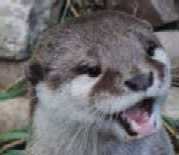
The teeth are modified for crushing rather than slicing - shearing edges are present, with pointed cusps, but are very broad, and powered by strong cheek muscles - they can crush crab and mollusc shells with them. The dental formula is
The eyes are round, and set a long way forward on the head; they appear larger in comparison to the head size, which helps give the animal an attractive look. The muscles that control the curvature of the eye are extremely strong, and react very rapidly when the animal passes from air to water; in bright light, the otter can see as well in water as on land. In dim light, however, their vision is better in air. Overall, their eyesight is roughly comparable to our own.
Body
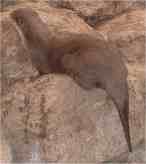 The Asian Small-Clawed Otter is rather a portly animal, with a thick layer of subcutaeous
fat; this is not used for insulation, however, as the animal relies on air trapped in the
fur for this. The distance between fore and hind paws is comparitively shorter than
in other otters, and the whole effect is more cat-like than is usual. The optimum
degree of plumpness in captivity is the subject of much debate. In the wild, this
obviously depends on prey availablity. The female has four teats, as is usual with
otters. The male baculum is baseball-bat shaped; the penis extends just beyond
the abdominal skin to form a preputial button. The animals have a pair of
anal scent glands, which produce a pale, milky liquid with a strong, but not
persistant smell. This is added to spraint, and is almost certainly conveys information
about sex, sexual state and receptivity, and maybe identity. The digestive system is very robust, and the gut is lined with a thick mucus layer, protecting it from the passage of sharp pieces of invertebrate shell. As in all otters, diving is accompanied by brachycardia - slowing of pulse-rate and circulation of blood, and hence reduced rate of oxygen extraction from the bloodstream. This is controlled by caval sphincter - a band of contractile muscle just above diaphragm which surrounds the first part of thoracic inferior vena cava, innervated by the phrenic nerve, which also supplies the diaphragm. Despite the slowing of heartbeat, the arterial pressure remains unchanged and the supply of blood to the brain is undiminished. This is what makes otters so hard to anaesthetize.
The Asian Small-Clawed Otter is rather a portly animal, with a thick layer of subcutaeous
fat; this is not used for insulation, however, as the animal relies on air trapped in the
fur for this. The distance between fore and hind paws is comparitively shorter than
in other otters, and the whole effect is more cat-like than is usual. The optimum
degree of plumpness in captivity is the subject of much debate. In the wild, this
obviously depends on prey availablity. The female has four teats, as is usual with
otters. The male baculum is baseball-bat shaped; the penis extends just beyond
the abdominal skin to form a preputial button. The animals have a pair of
anal scent glands, which produce a pale, milky liquid with a strong, but not
persistant smell. This is added to spraint, and is almost certainly conveys information
about sex, sexual state and receptivity, and maybe identity. The digestive system is very robust, and the gut is lined with a thick mucus layer, protecting it from the passage of sharp pieces of invertebrate shell. As in all otters, diving is accompanied by brachycardia - slowing of pulse-rate and circulation of blood, and hence reduced rate of oxygen extraction from the bloodstream. This is controlled by caval sphincter - a band of contractile muscle just above diaphragm which surrounds the first part of thoracic inferior vena cava, innervated by the phrenic nerve, which also supplies the diaphragm. Despite the slowing of heartbeat, the arterial pressure remains unchanged and the supply of blood to the brain is undiminished. This is what makes otters so hard to anaesthetize.
Tail
The tail of this species is very broad at the root, and tapers toward the end. Fat is stored in the broad part of the tail, and on older specimens, this can cause an exaggerated effect of a round bun with a skinny rat-tail attached.Legs and Paws
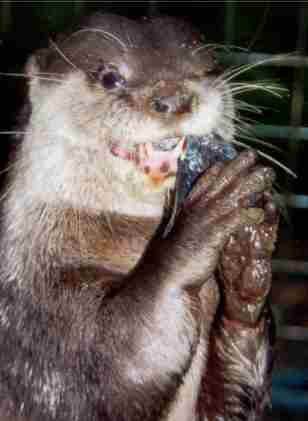 This species of otter relies on its forepaws for finding food. The claws are
vestigial, being minute spikes that do not project beyond the ends of the digital
pads. On the forepaws, the amount of webbing varies,
but never extends beyond the 2nd phalange, and all five fingers bear claws. The
hind paws are often more webbed, and bear tiny, erect claws on digits 2, 3 and 4,
which are used during grooming.
This species of otter relies on its forepaws for finding food. The claws are
vestigial, being minute spikes that do not project beyond the ends of the digital
pads. On the forepaws, the amount of webbing varies,
but never extends beyond the 2nd phalange, and all five fingers bear claws. The
hind paws are often more webbed, and bear tiny, erect claws on digits 2, 3 and 4,
which are used during grooming.
The digital pads are very sensitive, and the part of the brain that deals with sensory information from them is very much enlarged compared to that of the clawed otters. Correspondingly, the part devoted to input from the vibrissae is less well developed than in clawed otters.
Fur
As with most otters, the fur has two layers - longer, shiny guard hairs, and very dense, fluffy underfur. It is the air trapped in this underfur that the otter relies on for insulation when underwater, which explains why the animals spend a great deal of time grooming. fur qualityThe coat may be anything from pale ashy-brown to deep lustrous chocolate, with a lighter throat and a tide mark running from below the eye to below the ear.
Physiology
As well as the insulation due to air trapped in the underfur, these otters rely on rapid metabolic assimilation of food to maintain body termperature. At least 25% of body weight needs to be consumed per day; this takes between one and three hours to pass through the gut (depending on food type).Borgwardt & Culik (1998) found that in air, the metabolic rate is similar to that of larger otter species, i.e. double that of comparitively sized terrestrial mammals. In water, rest and swimming metabolic rates are 30% higher than expected compared to other otter species. This is probably because of high thermoregulatory costs and increased body drag at low Reynolds numbers.
| Asian Small-Clawed Otter |

